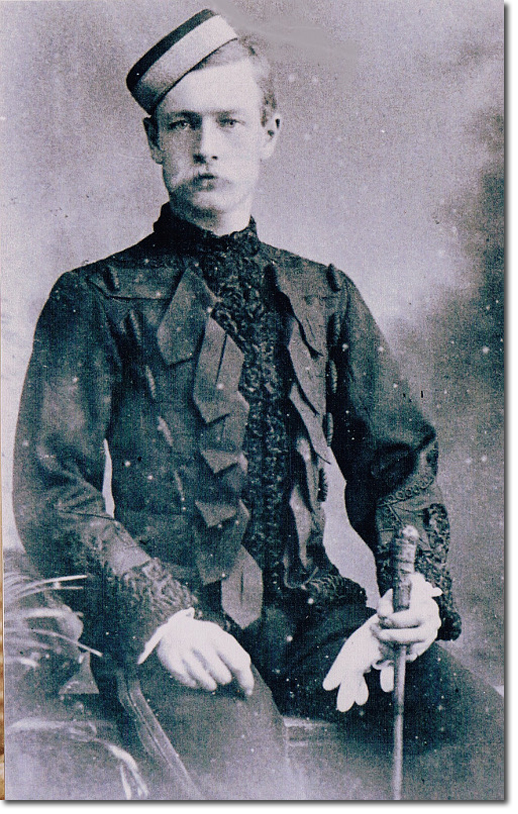|
|


|
|
Arthur Lawley was an officer of the 10th Hussars who went on to be a notable colonial administrator in Africa, Australia and India. He was born on 12 Nov 1860, the son of Beilby Lawley, 2nd Baron Wenlock and Lady Elizabeth Grosvenor daughter of the 2nd Marquess of Westminster. He was educated at Eton where he edited the Eton Chronicle. He went on to Trinity, Cambridge but did not complete his studies. In 1880 he entered RMA Sandhurst and was commissioned as Lieutenant in the 10th Hussars on 9 Aug 1882, promoted to captain on 10 Aug 1889. He was appointed adjutant on 20 Oct 1890. His active service was in the Sudan in 1884. He was with the 10th Hussars for 10 years, retiring from the army in 1892.
His political career began in 1892 when he was given the job of private secretary to his uncle the Duke of Westminster. In 1896 he was secretary to Earl Grey in Rhodesia. In Nov 1896 he was sent to administer Matabeleland, first as deputy, then as the administrator, until 1901. During that period his main achievement was persuading King Lewanika to sign a treaty in Barotseland. The Second Matabele War ended during his administration. In Feb 1901 Lawley was appointed Governor of Western Australia and given a knighthood. He was only in that post from 1 May 1901 to 14 Aug 1902. He represented Western Australia at the first Federal Parliament in Melbourne on 9 May 1901. There were 5 different governments during Lawley’s short administration. He was involved with various charities including the children’s hospice at Cottesloe. The suburb Mount Lawley in Perth is named after him. Following the Boer War the newly acquired Transvaal Colony was in need of an administrator, and Lawley was appointed the first Lieutenant-Governor. He was sworn in at Pretoria on 29 Sep 1902. He faced the task of helping the Boers rebuild their farms after the devastation that took place during the war. The gold and diamond mines were re-opened, and on 25 June 1905 the fabulous Cullinan Diamond was discovered and later presented to King Edward VII by Louis Botha. The Kruger National Park was created and the University of Witwatersrand was established. There was also the task of allotting separate reserves for the indigenous tribes but this was only 3% of the Transvaal. The question of the Kgatla reserves in Bechuanaland had to be settled and there was a dispute with Lord Milner over Milner’s importation of cheap Chinese labour for the mines. On 28 Dec 1905 Sir Arthur Lawley was appointed Governor of Madras. He took office in March 1906. His elder brother Beilby Lawley had held the post in the early 1890s. During his time in office the Madras Legislative Council was reformed and enlarged. He made many tours of the region and met with people in all walks of life in schools, prisons, hospitals etc. The Madras Estates Land Bill was passed and he introduced reforms to bring Indians into the government of Madras. He promoted the building of railways, encouraged modern farming practices and industrial development. In 1910 there was an Agricultural and Industrial Exhibition in Mysore. He inaugurated the Giffard School block of the Women and Children’s Hospital in Egmore in Oct 1911, and opened the Lady Lawley Nurses Home on 1 Nov 1911. In 1912 having finished his term of office in Madras, he was sent to North America to encourage the Canadians to build Dreadnoughts for the Royal Navy and to visit the USA where he made speeches in New York, Washington, Philadelphia and Chicago. During WW1 he worked for the British Red Cross in Boulogne and Mesopotamia. After the war he was involved in the founding of the International Red Cross and in many ventures abroad. Sir Arthur Lawley was the 8th of 9 children, and the 4th of 5 sons. He was briefly 6th Baron Wenlock from June 1931 until his death on 14 June 1932. His father had been 2nd Baron, and the title was inherited by eldest son Beilby who died in 1912, then Richard who died in 1918, and Algernon who died in 1931. Arthur was married to Annie Allen Cunard, youngest daughter of Sir Edward Cunard 2nd Bt and sister of Edward Cunard who had served in the 10th Hussars until his death in 1877. They had three children, a son and 2 daughters. The son, Richard died in 1909 so the title became extinct in 1932 as Arthur was the last surviving brother out of the five. The family lived at Tyntesfield, North Somerset. The photo shows Arthur Lawley in 1882 as a 22 year-old lieutenant in the undress uniform of the 10th Hussars. |
Western Australia | Western Australia Administrators
Armed Forces | Art and Culture | Articles | Biographies | Colonies | Discussion | Glossary | Home | Library | Links | Map Room | Sources and Media | Science and Technology | Search | Student Zone | Timelines | TV & Film | Wargames